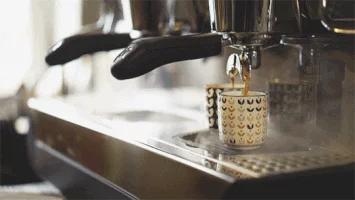This was funded by the National Science Foundation so you might as well enjoy it
Cell Press
 Mathematicians, physicists, and
materials experts might not spring to mind as the first people to consult about
whether you are brewing your coffee right.
Mathematicians, physicists, and
materials experts might not spring to mind as the first people to consult about
whether you are brewing your coffee right. But a team of such researchers from around the globe -- the United States, the United Kingdom, Ireland, Australia, and Switzerland -- are challenging common espresso wisdom, finding that fewer coffee beans, ground more coarsely, are the key to a drink that is cheaper to make, more consistent from shot to shot, and just as strong. Their work appears in the journal Matter.
"Most people in the coffee
industry are using fine-grind settings and lots of coffee beans to get a mix of
bitterness and sour acidity that is unpredictable and irreproducible,"
says co-senior author Christopher Hendon (@chhendon), a computational chemist at
the University of Oregon. "It sounds counterintuitive, but experiments and
modeling suggest that efficient, reproducible shots can be accessed by simply
using less coffee and grinding it more coarsely."
Though lots of factors are involved, the norm for brewing an espresso shot is to grind a relatively large amount of coffee beans (~20 grams) almost as finely as possible.
The fine grind, common sense goes, means more surface area exposed to the brewing liquid, which ought to boost extraction yield -- the fraction of the ground coffee that actually dissolves and ends up in the final drink.
But when the researchers put
together a mathematical model to explain the extraction yield based on the
factors under a barista's control -- options such as the masses of water and
dry coffee, the fineness or coarseness of the grounds, and the water pressure
-- and compared its predictions to brewing experiments, it became clear that
the real relationship was more complicated.
Grinding as finely as the industry standard clogged the coffee bed, reducing extraction yield, wasting raw material, and introducing variation in taste by sampling some grounds and missing others entirely.
Grinding as finely as the industry standard clogged the coffee bed, reducing extraction yield, wasting raw material, and introducing variation in taste by sampling some grounds and missing others entirely.
Much number crunching and thousands
of shots later, the team reached a recipe to simultaneously maximize extraction
and produce espresso that would taste similar from one cup to the next.
"One way to optimize extraction and achieve reproducibility is to grind
coarser and use a little less water, while another is to simply reduce the mass
of coffee," Hendon says.
Developing a model representative of
espresso brewing was not a straightforward task. At a basic level, extraction
yield depends on how water flows under pressure through a mass of coffee
grounds.
But that mass is made up of millions of individual grains of different shapes and sizes, jammed irregularly into a single filter bed.
"You would need more computing power than Google has to accurately solve the physics and transport equations of brewing on a geometry as intricate as a coffee bed," says co-senior author Jamie M. Foster, a mathematician at the University of Portsmouth (UK).
But that mass is made up of millions of individual grains of different shapes and sizes, jammed irregularly into a single filter bed.
"You would need more computing power than Google has to accurately solve the physics and transport equations of brewing on a geometry as intricate as a coffee bed," says co-senior author Jamie M. Foster, a mathematician at the University of Portsmouth (UK).
To get past this hurdle, the researchers drew on an unlikely source -- electrochemistry -- likening how caffeine and other molecules dissolve out of coffee grounds to how lithium ions move through the electrodes of a battery.
Borrowing modeling methodologies from battery work led to a rigorous coffee extraction model capable of making powerful and testable predictions.
Boosting the extraction yield
through one or more of the routes illustrated by the model could also lead to
economic gains for cafes and to sustainability benefits for the coffee industry
as a whole.
For example, at the current price of roasted coffee beans, dropping the mass of dry coffee from 20 grams to 15 grams per drink would add up to savings of a few thousand dollars per year for a small cafe, and $1.1 billion per year if scaled up to the whole US coffee industry.
Being more efficient with coffee bean usage would also reduce waste at a time when coffee supply is under threat from changing climate in historic production areas.
For example, at the current price of roasted coffee beans, dropping the mass of dry coffee from 20 grams to 15 grams per drink would add up to savings of a few thousand dollars per year for a small cafe, and $1.1 billion per year if scaled up to the whole US coffee industry.
Being more efficient with coffee bean usage would also reduce waste at a time when coffee supply is under threat from changing climate in historic production areas.
The researchers stress, however, that their results do not purport to reduce all of espresso making down to a single set of brewing conditions or to a lone flavor profile. "Though there are clear strategies to reduce waste and improve reproducibility, there is no obvious optimal espresso point," says Hendon.
"There is a tremendous dependency on the preferences of the person producing the coffee; we are elucidating the variables that they need to consider if they want to better navigate the parameter space of brewing espresso."
Computations for this work were
supported by the National Science Foundation (NSF) through the Extreme Science
and Engineering Discovery Environment (XSEDE).